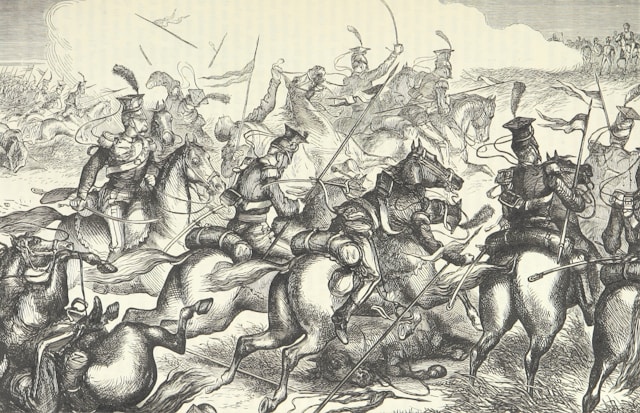Table des matières Afficher
Le bataille de la Montagne BlancheLa guerre de Trente Ans, qui eut lieu le 8 novembre 1620, fut un moment crucial dans les premières phases de la guerre de Trente Ans, une guerre terrible et interminable qui dévasta l'Europe de 1618 à 1648. Cette bataille décisive a changé le cours de la Bohême ainsi que le climat religieux et politique de l'Europe. La bataille a eu des conséquences considérables pour la région et le continent dans son ensemble, et a abouti au triomphe des catholiques sur les protestants.
Le bataille de la Montagne Blanche, surnommée ainsi en raison des pentes enneigées qui entourent Prague, a changé le paysage religieux et politique de l'Europe. La victoire des catholiques cimente l'autorité des Habsbourg sur la Bohême tout en ouvrant la voie à la contre-réforme qui s'enracine dans toute l'Europe.
Que s'est-il réellement passé en ce jour fatidique ? Comment une armée catholique en infériorité numérique et en manque d'armes a-t-elle pu vaincre les protestants de manière aussi décisive ? Découvrez comment les commandants habsbourgeois, en particulier le général Tilly, ont déjoué les plans de leurs adversaires et les ont battus à chaque étape de la bataille. Bataille de la Montagne Blanche.
Introduction à la bataille de White Mountain
Les tensions religieuses et politiques qui ont marqué le début de l'Europe au XVIIe siècle ont conduit à la création de l'Union européenne. bataille de la Montagne Blanche.
Le Saint Empire romain germanique, une confédération d'États d'Europe centrale, était au cœur de ces différends. La paix d'Augsbourg (1555) a établi un équilibre délicat, en accordant à chaque souverain le droit de décider si son royaume serait majoritairement catholique ou luthérien. Cet arrangement n'a pas permis de faire face à l'émergence du calvinisme ni de résoudre les conflits persistants entre les groupes catholiques et protestants.
Une crise aigüe a éclaté en Bohême parce que les domaines protestants de l'aristocratie bohémienne ont rejeté le roi Ferdinand II, un catholique qui voulait restaurer les droits de l'homme et les droits de l'homme. La suprématie catholique à Prague. La défenestration de Prague, au cours de laquelle les dirigeants protestants ont jeté par la fenêtre deux des dirigeants catholiques de Ferdinand, a déclenché le soulèvement de la Bohême en mai 1618.
Après avoir déposé Ferdinand, les rebelles ont choisi comme roi le protestant Frédéric V du Palatinat. Cette rébellion a ouvert la voie à une lutte plus vaste, connue sous le nom de guerre de Trente Ans.
Causes et prélude à la bataille de la Montagne Blanche
Le Bataille de la Montagne Blanche sont le résultat de décennies de conflits religieux et politiques. La réforme protestante, l'éclatement du Saint Empire de Rome et l'étincelle immédiate de la guerre de Sécession sont autant de facteurs qui ont contribué à l'essor de l'Europe. Défenestration de Prague tous ont conspiré pour déclencher la révolte de la Bohême. Ce combat, marqué par le triomphe éclatant de la Ligue catholique, a jeté les bases des guerres suivantes et a eu des conséquences considérables sur la guerre de Trente Ans et le destin de l'Europe. Voici un bref aperçu des causes et de l'évolution de la guerre de Trente Ans. bataille de la Montagne Blanche:
Causes de la bataille de la Montagne Blanche
Conflits religieux et réforme : La réforme protestante de Martin Luther en 1517 a divisé la religion européenne en groupes protestants.
Troubles politiques et luttes de pouvoir : L'empire se compose d'États semi-autonomes où l'empereur et les princes se livrent régulièrement à des luttes de pouvoir.
Crise de succession : Après la mort de l'empereur Matthias (1619), Ferdinand II, catholique, est élu pour recatholiciser l'empire et consolider son pouvoir, ce qui dérange les seigneurs protestants.
Prélude à la bataille
Défenestration de Prague (1618) : La noblesse protestante, furieuse des restrictions religieuses imposées par Ferdinand, jette deux fonctionnaires catholiques par la fenêtre, ce qui déclenche la révolte de Bohême.
Formation de l'Union protestante : La noblesse protestante renverse Ferdinand et élit le calviniste Frédéric V du Palatinat comme roi de Bohême, en cherchant le soutien d'autres nations protestantes et de puissances étrangères.
Mobilisation militaire : La ligue catholique soutient Ferdinand II sous la direction de Maximilien Ier de Bavière et du général Tilly, renforçant ainsi la puissance militaire catholique.
De mars à Prague : En octobre 1620, l'armée de la Ligue catholique se rend à Prague pour réprimer la révolte des Bohémiens et se réunit à la Montagne Blanche.
La bataille de White Mountain le 8.11.1620
Deux troupes se sont battues sur la Montagne Blanche, à l'extérieur de Prague, en République tchèque, le 8 11, 1920. Motivés par la réforme, les protestants se sont battus pour la liberté religieuse et contre la tyrannie catholique. Cependant, les soldats catholiques, menés par le brutal général Tilly, tentent d'anéantir le soulèvement protestant et de restaurer le pouvoir catholique.
Les deux camps s'affrontent violemment dans l'espoir de remporter la victoire. Les hommes bien disciplinés du comte Tilly ont rapidement vaincu les protestants, qui étaient en infériorité numérique. Malgré les efforts des troupes de Frédéric V, les troupes impériales catholiques sont trop fortes.
Le protestant a été dévastée par la victoire des catholiques sur l'Union européenne. bataille de la Montagne Blanche. Frédéric V s'exile et la révolte des Bohémiens est écrasée sans pitié. Alors que la guerre de Trente Ans se poursuit pendant trente ans, la défaite de la Montagne Blanche marque le début d'une longue et difficile résurgence catholique dans toute l'Europe.
Conséquences de la bataille de la Montagne Blanche
La Bohême, l'Europe centrale et le Saint Empire romain germanique ont tous été profondément et largement affectés par la guerre de Sécession. bataille de la Montagne Blanchequi a eu lieu le 8 novembre 1620. En voici les principaux résultats :
Fin du soulèvement
La révolte de la Bohême s'achève avec la défaite de la Montagne Blanche. Après la prise de Prague par les armées catholiques, Frédéric V s'exile.
Répression
Les protestants de Bohême ont été durement persécutés par Ferdinand II, qui a ordonné leur assassinat, les a bannis du pays et a saisi leurs biens. La recatholisation de la Bohême est imposée au peuple.
Effets à long terme
Influant sur la trajectoire plus large de la guerre de Trente Ans et transformant le terrain politique et théologique de l'Europe centrale, le triomphe de White Mountain a consolidé la domination de Ferdinand II et la position catholique à l'intérieur du Saint Empire romain germanique.
Héritage et commémoration de la bataille de White Mountain
Le bataille de la Montagne Blanche a été un événement européen terrible et crucial. Il a montré à quel point les conflits religieux et politiques du début de l'ère moderne étaient volatiles et catastrophiques. Le conflit a marqué la fin de l'indépendance tchèque et le début de la domination des Habsbourg.
Des monuments, des mémoriaux et des initiatives éducatives commémorent le combat. Des études historiques et des activités culturelles encouragent le public à réfléchir à son héritage.
White Mountain illustre le lien entre les luttes locales et continentales pendant la guerre de Trente Ans. La fin de la bataille a eu des répercussions sur la Bohême et sur l'équilibre des pouvoirs en Europe. Elle a montré la fragilité des alliances et la façon dont les batailles militaires façonnent les relations entre l'Europe et la Bohême. l'histoire.





